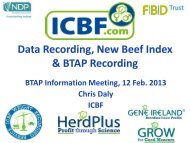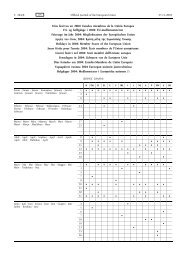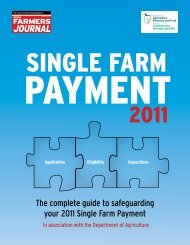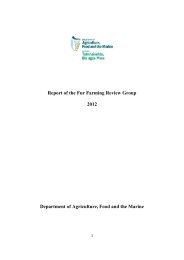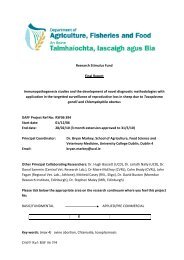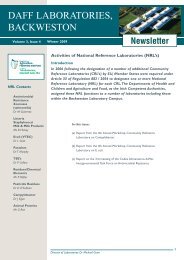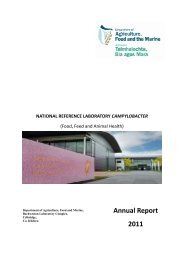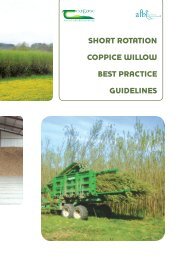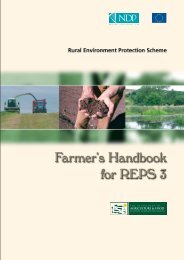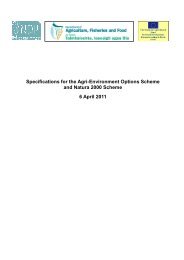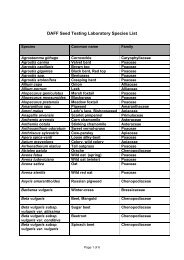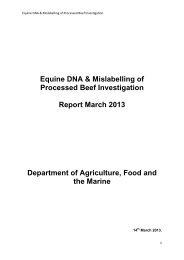Food Research Ireland - Department of Agriculture
Food Research Ireland - Department of Agriculture
Food Research Ireland - Department of Agriculture
You also want an ePaper? Increase the reach of your titles
YUMPU automatically turns print PDFs into web optimized ePapers that Google loves.
Microbial hazards, including foodborne viruses, if present in the food<br />
chain will always be a threat to <strong>Ireland</strong>’s brand reputation and to public<br />
health. For example, bacteria colonising the production chain are subject<br />
to food processing stresses designed to control them. However, some<br />
strains <strong>of</strong> bacteria alter their phenotype as a consequence <strong>of</strong> these<br />
control measures. This evolutionary phenomena can lead to harmful<br />
bacteria surviving along the food chain. <strong>Research</strong> that seeks to<br />
understand the underlying mechanisms that contribute to this altered<br />
microbial behaviour in the food processing environment is continuously<br />
needed. <strong>Research</strong> efforts, including the exploitation <strong>of</strong> databases, have<br />
contributed and should continue to contribute to the development <strong>of</strong><br />
new food safety risk assessment models as well as developing the<br />
technical expertise and knowledge relevant to all sectors <strong>of</strong> <strong>Ireland</strong>’s<br />
food processing industry; however, ongoing research is required.<br />
<strong>Research</strong> Objectives:<br />
■ Isolation, characterisation and prediction <strong>of</strong> the behaviour <strong>of</strong> existing<br />
food-borne pathogens and emerging pathogens (new and those<br />
which are exhibiting antimicrobial resistance) in food systems, to<br />
facilitate decisions on metrics, to enable adequate control measures<br />
and their validation, and to support risk assessment;<br />
■ Investigation <strong>of</strong> the relationship between food processing stress(es)<br />
– such as heat, pH and others, encountered by zoonotic (food-borne)<br />
bacteria and their transcriptomes/proteomes, to uncover <strong>of</strong>f-line<br />
mechanisms that can be translated into improved food safety<br />
controls;<br />
■ Predicting in a timely manner the emergence <strong>of</strong> new bacterial<br />
strains and serotypes <strong>of</strong> public health significance and the<br />
underlying role <strong>of</strong> horizontal gene transfer in the emergence <strong>of</strong><br />
virulent bacteria such as verocytotoxigenic E. coli and bacteria<br />
with multi-antibiotic resistance;<br />
■ Application <strong>of</strong> predictive microbial modelling and risk assessment to<br />
predict public health risk posed by pathogens in particular food<br />
products and process chains and to strategically assess the benefit <strong>of</strong><br />
risk reduction measures;<br />
■ Identification and development <strong>of</strong> antibacterial agents that are<br />
effective against key pathogens. Where appropriate, existing<br />
research knowledge should be further developed with a focus on<br />
application <strong>of</strong> such agents in key parts <strong>of</strong> the food chain from<br />
primary production (cattle, pigs, and poultry) through to<br />
decontaminants for animal coats, and carcasses to applications in<br />
food processing and distribution (packaging);<br />
■ Isolation, characterization and application <strong>of</strong> novel antifungal/anti-microbial<br />
compounds for use within the food<br />
industry including:<br />
■ the application <strong>of</strong> natural antimicrobial compounds<br />
encapsulated in nanosomes as a means <strong>of</strong> reducing the<br />
burden <strong>of</strong> pathogens at primary production such as<br />
Campylobacter in the gastrointestinal tract <strong>of</strong> avians or<br />
Salmonella in pigs and also application <strong>of</strong> such nanomaterials<br />
as part <strong>of</strong> a natural food packaging solution at<br />
the consumer end <strong>of</strong> the food chain;<br />
■ increasing shelf life <strong>of</strong> food products including dairy, fish,<br />
meat, cereals and fresh cut produce;<br />
■ Development <strong>of</strong> quantitative risk assessments for key<br />
pathogen/commodity combinations to underpin risk<br />
management approaches to pathogen reduction in meats;<br />
■ Effect <strong>of</strong> chilling rates <strong>of</strong> hot/warm-boned meat on the spoilage,<br />
especially blown pack spoilage and assessment <strong>of</strong> the safety<br />
risks associated with spoilage;<br />
■ Preservation systems to improve shelf life and facilitate access to<br />
new markets via longer distribution chains whilst maintaining<br />
quality and safety;<br />
■ Development <strong>of</strong> rapid methods for the identification <strong>of</strong><br />
microbiological contamination.<br />
<strong>Food</strong> <strong>Research</strong> <strong>Ireland</strong><br />
▼<br />
43



